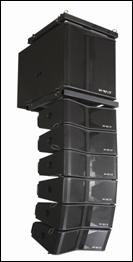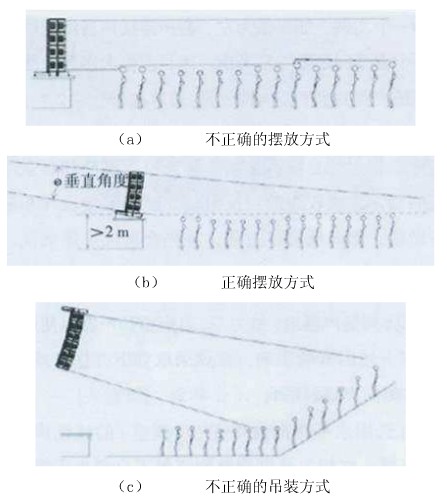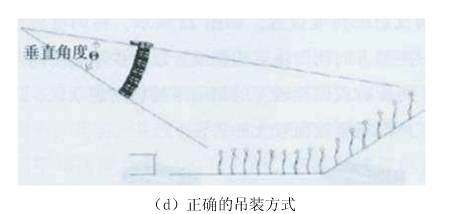First, the basic arrangement of the linear sound source array speaker system, the line array speaker system has several characteristics in the application.
(1) Usually the middle and high frequency speakers are more than 4; the low frequency speakers are more than 2;
(2) Most of them are hoisted. There are generally 3 ways to hoist, and the speaker is hoisted into a similar letter "J", as shown below:

The speaker distribution is arranged from top to bottom according to the long-distance projection box, the medium-distance projection box, the close-range field projection box, and the near-field projection box. The subwoofer can be arranged in the whole row of the middle and high speakers according to the needs and positions. It can also be arranged in the upper end of the middle and high speakers, even behind the whole row of the middle and high speakers, and can be hanged in parallel.

H-WIT LA-208/LA-410 line array speaker hanging diagram
(3) The method of placing the ground can be used. However, the linear sound source array speaker (box) (group), whether it is hoisting installation or ground placement, has a large horizontal angle and a large number of groups, which generally meets the requirements of the audience area coverage. The vertical angle can be adjusted, so pay special attention to the relationship between the vertical radiation angle and the audience, as shown in the following figure:


In fact, there is only one key point in the correct placement and lifting method, that is, the vertical coverage angle must cover all the audience areas before and after. If the distribution area of ​​the audience is too large before and after, the J-type or arc (curved) radiation angle can be adjusted to increase the angle to ensure the coverage of the audience area. If you adjust to the maximum angle, you still can't meet the needs of the audience area. You can take the following two methods:
(1) Move the lifting position back and increase to widen the vertical coverage radiation angle, but this method is restricted by the sensitivity and power of the speaker. Although the rearward position and the increased lifting position meet the needs of the front and rear coverage of the audience area, the sound pressure level Attenuation, the high frequency and low frequency are weakened in the entire frequency band, and the sound field unevenness is increased, which affects the overall hearing, and this method cannot be adopted;
(2) The former method does not work. The last method can only increase the number of array speakers, or use more sound pressure sensitivity. The higher power speakers meet the sound pressure level, sound field unevenness coverage and hearing needs.
Second, the application of line array speaker system
The linear sound source array speaker is suitable for outdoor sound reinforcement with many auditoriums such as stadiums and outdoor squares; it is also suitable for indoor large venues such as gymnasiums, multi-purpose halls, banquet halls, theaters, large halls, etc.; Temporary sound reinforcement system, because the linear sound source array speaker has the characteristics of transportation, combination, installation and debugging, it is still favored by the majority of users.
2.1 Outdoor use
Outdoor use is the preferred application for linear sound source array speaker systems, such as stadiums, outdoor performances, entertainment parties, large-scale charity events, mass gatherings, and large-scale competitions. When using it outdoors, it is recommended to pay attention to the following problems.
(1) Pay attention to the safety and reliability of the hoisting truss of the linear sound source array speaker set.
(2) Pay attention to the number of speakers of the linear sound source array and the arrangement position of the group and the performance area, the performance sound image and the sound gain.
(3) If there is a large video projection screen or other display screen hanging on the lifting truss of the speaker group, mutual position conflict and load bearing load (especially dynamic load) must be considered.
(4) Consider the adverse weather effects such as wind, rain, snow, and haze
2.2 Indoor use
Due to the characteristics of line array loudspeakers, great development and application have been made in recent years, especially in the field of outdoor mobile sound reinforcement. The advantages of several line array speakers for indoor use are summarized.
(1) The indoor sound field distribution is more uniform
By using the directivity factor of the line array speaker and its strong directivity, it can compensate for the defect that the sound pressure level is excessively attenuated due to the increase of the distance in the distance, and the indoor sound field distribution tends to be more uniform. At the same time, due to the effect of indoor reverberation, the generation of reverberant sound energy can further improve the uniformity of the indoor sound field.
(2) Reduce the effective reverberation time in the hall
When the line array is used in the hall, the effective reverberation time in the hall can be shortened. This is because the line array speaker has strong directivity, and the main sound beam is directed to the auditorium, which can enhance the direct sound energy and reduce the acoustic ratio of the room, thereby reducing the effective reverberation time. In particular, the reverberation time of large stadiums is generally long. In order to meet the requirements of competitions and performances, and to ensure clarity, the use of line array loudspeakers has great advantages.
(3) Improve the sound transmission gain of the entire sound reinforcement system
It is well known that the sound radiated from the speaker in the sound reinforcement system is fed back to the microphone to cause distortion and howling. Acoustic feedback severely affects the use of the entire sound reinforcement system. In order to suppress the acoustic feedback and increase the sound gain, in addition to the microphone with strong directivity, the use of speakers with super directivity is also an important link. Since the line array speaker has strong vertical directivity, the sound pressure level is rapidly attenuated outside its effective coverage angle, and the sound feedback is often improved to increase the sound gain. Combined with this feature, it can better meet the acoustic gain requirements of the acoustic characteristics of the indoor sound reinforcement system.
All of the above measures can reduce the influence of unwanted lateral acoustic radiation, improve sound amplification efficiency, ensure better uniformity of sound coverage and good hearing, and increase sound transmission gain. For specific application, it is necessary to select the most economical and best-performing solution according to the construction structure of the site, the investment cost of the sound system, the conditions of the existing equipment, and other factors.
Ningbo Autrends International Trade Co.,Ltd. , https://www.mosvape.com